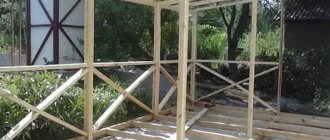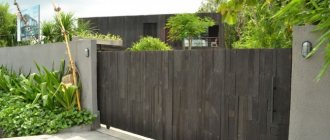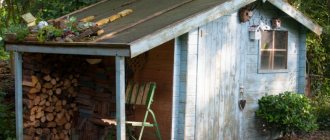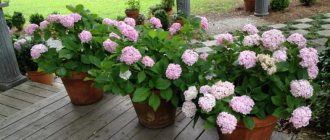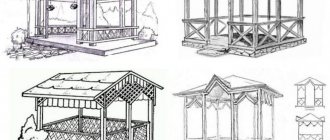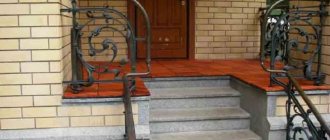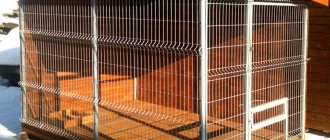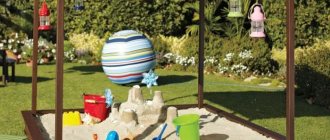What should a dog's enclosure be like?
A good enclosure for keeping a dog should be:
- durable;
- warm;
- dry;
- convenient for cleaning;
- durable.
Attention! Under no circumstances should the enclosure be used as a place of punishment for a dog. The animal must feel that the territory inside the enclosure belongs only to it and that it is safe here.
What does a dog enclosure look like?
An enclosure for a dog is a structure in which the animal can live and walk peacefully, without being subjected to severe stress and precipitation. The enclosure looks like a spacious cage, with enough space for movement and a house for spending the night.
What dogs live in the enclosure?
Alabais , Shepherds , Mastiffs and other large dogs in enclosures . If the dog is small and at the same time aggressive, then it is also worth keeping it in an enclosure. Kennels where females and puppies .
What are the sizes of dog enclosures?
The size of the enclosures depends on the size of the animal, the area of the yard of a private house or cottage, as well as the preferences of the dog owner and his financial capabilities. Small enclosures with an area of 3 m2 or more are used for keeping medium-sized dogs and for keeping large dogs for several hours a day - at a time when the owners are not able to look after them. Large enclosures with an area of 6-10 m2 are suitable for round-the-clock and year-round housing of shepherds and other large dogs that do not tolerate chains well and can cause great harm if they are not under the supervision of their owners.
What is a dog enclosure made of?
Dog enclosures are made from metal, profile pipe , chain-link mesh, as well as timber and floorboards. For the roof, corrugated sheets or soft tiles can be used. Inexpensive and reliable heat-insulating materials such as polystyrene foam are used for insulation.
Where to place a dog enclosure on the property?
If you got an animal for protection, you can place its enclosure opposite the entrance to the yard. In this case, you need to choose a place in the yard that will not be in close proximity to an outdoor toilet, gazebo, chicken coop and other outbuildings. It is possible to place a dog enclosure near a residential building, because if it is too far from it, the owners will pay very little attention to the animal and the dog will feel abandoned.
You should not install an enclosure along the fence , otherwise the animal will bark all day long, reacting to pedestrians or neighbors. Choose a place to install this structure that is not blown by winds or flooded during heavy rain, otherwise the life of the animal will be greatly reduced.
Do-it-yourself outdoor for a private home
These are popular in dachas and large estates for large guard dogs. Keeping them chained is inhumane to the animal and irresponsible in terms of protecting your property. The chain was relevant when the local area was small. With the increase in the local area, this has lost its meaning: if at least some area is inaccessible to the dog, then the house is not protected.
In addition, a dog on a chain is an easy target for a serious thief, and losing a pet guard is not only sad, but also very expensive. After all, a well-trained guard dog is expensive. All this together is a compelling argument for making a house with your own hands, and letting the animal in there and letting it out at night.
Interesting: it has been proven that an animal living in an enclosure shows less aggression than one living on a chain. This is important if, in addition to the dog, there are children living in the house.
The following argument against building an enclosure often arises: the dog is friendly and roams freely around the area. Let's say the dog is really safe for everyone in the household, but what to do if your neighbors, guests, or utility workers come to the site? To avoid frantically starting to come up with ways to isolate a large animal, it is better to take care of this in advance.
Important : the outdoor enclosure must be a full-fledged home for the dog.
Indeed, guard dogs have been domesticated for a long time and today they need a cozy kennel and territory that they will protect. If you build an outdoor enclosure for a dog, following all the rules, spacious and cozy, it will not be perceived as a cage.
Collapsible aviary
Outdoor enclosures for dogs can be either prefabricated, dismountable, or stationary. The first ones are more universal; they can be moved or removed at any time as unnecessary, for example, if the enclosure was placed on a summer cottage and is not needed in winter.
These enclosures can also be called differently: permanent - a whole complex for keeping a dog, with a booth, a bed and a walking area; or simply a fenced area of territory - temporary .
Functions of an outdoor enclosure:
- restriction of free-range territory;
- ensuring the safety of the animal;
- protection from weather conditions (cold, rain, etc.);
- satisfying the dog’s desire to isolate itself from time to time, the need for its own territory.
Important : for an outdoor enclosure, it is important to have a walk - a spacious area in the fresh air, which will allow the pet not to sit locked up all day.
Aviary with walking area
Aviary layout:
Dimensions
Before you properly build a home enclosure with your own hands on the site, you must prepare a drawing so as not to make a mistake with the size and quantity of materials needed. The dimensions of the building are chosen based on standards developed by experienced dog breeders. You also need to take into account the breed of your pet.
The size of the enclosure will depend on:
- size of the animal;
- its breed;
- number of dogs in the building;
- the purpose of the enclosure - will the dog live there permanently, or walk around the territory.
The minimum area of a dog's house on the street is calculated based on the height of the animal at the withers:
- up to 50 cm – 6 sq. m;
- up to 60 cm – 8 sq. m;
- from 60 cm and above – from 10 sq. m.
Drawings with dimensions:
Other parameters are also calculated based on the animal’s body : the width must be at least one and a half body lengths (but without the tail). At the same time, you should not make the width less than 1.5 meters, even for small dogs. The length is calculated by area and width.
For the enclosure you need to calculate the height. To make this more difficult: you need to lift the dog by its front legs until it stretches to its full length. You will need an assistant to measure the distance from the front paws to the ground. Then you need to add another half meter to the resulting figure - this is the minimum height.
Important: there are especially jumping breeds of animals. For example, huskies are now fashionable: in their homeland, these dogs jump very high, this helps them navigate the endless white snow. To prevent the dog from jumping out of the enclosure, you will have to raise the walls higher.
All the above figures were given per animal. For two adult dogs, this area will need to be increased by one and a half times. The enclosure for a female dog with babies should be even larger, because the animals will actively explore the world.
You also need to pay attention to the breed : huge enclosures are perfect for large or active breeds - they will be able to warm up at any time. But bigger is not always better: a small dog in a large room will get lost in every sense. She will be scared and uncomfortable there.
Important : an outdoor enclosure is not suitable for permanent habitat of dwarf breeds; they do not overwinter in our climate.
The enclosure for breeds such as husky and alabai , which often appear in private homes, deserves special attention. What kind of enclosure should be for them?
Husky , as already mentioned, jumps well, so if you don’t want to catch it all over the area, raise the walls higher. This dog is also very active and sociable. In general, she is not suitable as a guard animal: she is too loving and gets bored easily. An enclosure for her can be set up only for the purpose of constant walking: the house will be a bit cramped for her. Even though the breed does not exceed 60 cm at the withers, it will need an area of 10 to 15 squares, with an aspect ratio of 2:3.
The size of the enclosure for the Alabai must correspond to this giant: in a small enclosure (as well as on a chain), the animal will quickly become embittered and become dangerous for the owner. This dog can also surprise with its jumping ability: an adult Alabai is able to jump over a height of about 3 m.
So before you build a do-it-yourself pen for your home, be sure to think it through carefully!
Materials
The main criteria here are safety for the owner and the animal . That is, the dog should not break free, nor should it be injured while trying to do this, or simply while living in an enclosure. If the building is stationary, one wall should be made blank, made of wood or even brick.
Often, in order to save money, the enclosure is attached directly to the wall of the house or to the fence:
Very stylish dog run
The remaining walls are made of lattice, from:
- Wooden or metal rods. Rods are the most reliable option, and this type of fencing is also easy to repair.
- Chain-link mesh. Chain-link mesh should only be used when there is not enough money for anything else: this cheap material can harm the dog. She can scratch herself on it, or break her teeth trying to gnaw through the mesh. But the chain-link is very easy to install.
- Forged. Forged enclosures are very beautiful, durable, but at the same time expensive.
- Made from galvanized pipes. A structure made of galvanized pipes will require considerable effort at the construction stage, but then it will last a long time.
Important : no matter what material you choose, you need to take care of its coating. The metal is coated with a special paint that prevents corrosion, and the wood is impregnated with a composition that will provide protection from rot and wood-boring beetles.
A winter outdoor enclosure must have a winter road! The winter road is a separate, carefully insulated room adjacent to an enclosure with a warm booth. We recommend that you build just such enclosures - they are the most profitable and convenient for your pet:
Building walls
How to do it yourself? The walls of the enclosure serve as a fence for a dog that wants to go outside. They bear the brunt of the load, so pay special attention to them. Before building walls, you need to take care of the foundation. There are several options here:
- The perimeter of the future structure is outlined, a trench is dug and a strip foundation is made.
- A columnar foundation is made only in those places where the supporting elements will be installed.
It is impossible to build walls without a foundation: the soil will subside over time, and the enclosure may become damaged.
Outdoor enclosures, as a rule, are built from metal or durable wood so that, in case of emergency, it can withstand the pressure of a large adult animal. In addition, an enclosure made of such materials will last a long time if it is used correctly.
A good option for an animal is a brick enclosure ; it will be warm and cozy, neither rain nor wind will get inside.
You can also make the enclosure out of wood: it’s easier, because you don’t have to do the masonry yourself. Often these options are combined: one brick wall and three made of metal lattice. Or a frame is welded from steel pipes and then sheathed in wood.
In practice, the best option is a welded rod fence . It is done according to this scheme:
- Make a frame.
- Make a lattice from cut rods, welding the fittings to a metal frame from a corner. The distance between the bars for large dogs is 10 cm, for others - approximately 5.
- Connect the frame to the support pillars using the same welding.
- Check whether all the elements are securely welded, or whether they are simply stuck: with a strong push, the animal will knock them out.
- Treat the structure against rust.
Important: a door must be built into the walls.
It should not be done in a blank wall: it is comfortable for the animal to see that someone is approaching it and will come in now. You should make sure that the door opens inward and not outward, otherwise your pet will easily knock it down. And in a fit of joy when greeting the owner, the dog can hit him with the door.
The door here is not made perfectly
Floor
So, let's build the floor! Gender is no less important. The trampled ground is definitely not suitable: some dogs like to dig around, and will quickly render the enclosure unusable. And the raccoon dog and a number of other breeds will dig their way to freedom without much effort.
The other extreme - a floor filled with concrete, “so as not to crawl out”, is also undesirable. These floors are cold, especially in winter, which will cause your dog to suffer and may get sick. A couple of years on a concrete floor and problems with paws are guaranteed .
It's best to stick with wood floors . They are warm and easy to install.
To make such a floor, you need:
- Prepare boards about 40 mm thick and rectangular beams.
- Treat the material with an antiseptic.
- Make a frame for the deck.
- Lay the boards on the frame, adjust the seams, then secure the flooring with self-tapping screws. The heads of the screws need to be recessed and puttied so that the dog does not get hurt.
- Paint the floor or varnish it.
Important : do not skimp on paint; a cheap and toxic product will damage a dog’s sense of smell, and without painting at all, the floor will quickly rot.
Making a roof
To build the roof, slate, tiles, corrugated sheets, siding or regular tarpaulin are used. The main thing is that the material does not resonate from wind and rain; this will damage the dog’s hearing, which is no less sensitive and subtle than the sense of smell. Soft tiles or fabric will solve this problem. Most often, the roof is made of the simplest, pitched roof.
Important: the roof must have a gap for ventilation, because heat and stuffiness are very harmful for the dog.
An excellent option is an awning . First you need to build a metal or wooden frame, and then stretch a fabric roof over it. The material must be waterproof. But the problem is that it’s difficult to sew such a tent yourself, and it’s not cheap to buy.
Chain-link enclosures with a tent roof. Not suitable for permanent housing
The simplest option is made of slate, siding or corrugated board. In this case, the frame is also built first. The roofing of the enclosure is laid on a reliable, well-sanded roofing system.
Feeder
The main stages of construction are behind us, the question remains of what the future inhabitant of the enclosure will eat from. There are several requirements for the feeder:
- raised above the ground to a height of 20-30 cm, that is, at the height of the lower edge of the dog’s chest, depending on its size. It is undesirable for these animals to eat from the floor, it is harmful to the back and paws;
- There are separate areas for food and water. Mixing must be avoided;
- the presence of a rotating mechanism in the feeder and the ability to fix it. This way, not only the owner, but also other people will be able to feed the dog safely in his absence.
The easiest way is to simply weld several bowls to the rods, but they will not spin. For the rotating device, a small rectangular frame is planned in advance in the frame, into which the rotating device of the feeder and drinker is inserted.
Scheme drawing:
How to make the toilet comfortable for the animal and the owner?
And finally, an important part of any enclosure is the toilet. It is advisable to immediately train the animal to relieve itself in one place, otherwise the number of general cleanings in the enclosure will increase from one annual, scheduled one to infinity. You can do it like this:
- Prepare a vessel suitable in size for the dog: from a bowl to a basin.
- Make a cutout in the floor for the toilet, placing it at a distance from the feeder and the booth.
- Temporarily cover the hole with board or plywood.
- Let the dog into the enclosure. For a while she can relieve herself anywhere.
- When the animal gets used to it, its waste is collected, but not thrown out. The dog needs to be taken out of the enclosure and cleaned up.
- After cleaning, the toilet is put back into place. The bowl is filled with sand and the pet's waste is placed on top.
- The dog is released into the enclosure. Now she will go to the toilet in the designated place, perceiving it as marked by herself. Sand is needed so that the animal can rummage; it will have to be changed periodically.
The method does not always work; sometimes the dog relieves itself everywhere. To make cleaning easier, the floor in the enclosure in this case is made with a slight slope towards one of the side walls or towards the facade. So it’s easy to wash off the sewage with a hose; with some skill you don’t even have to go inside.
Options and types of enclosures for large dogs
For large dogs we offer options such as:
- outdoor winter with walking;
- reinforced with winter road;
- beautiful made of wood.
Outdoor winter enclosure with walking
Such an enclosure has a large additional area for walking the animal, fenced with rods or chain-link mesh, with an earthen floor. The animal will feel best in it.
Reinforced enclosure with winter road (warm)
This design with a warm booth is intended for keeping aggressive or large animals that are capable of breaking out and running away or biting passers-by.
Beautiful wooden enclosure for a dog
A building for keeping a dog in the courtyard of a private house, which has additional decorations in the form of forged, carved or other elements, is intended for those dog owners who value not only practicality, but also aesthetics, and also do not skimp on their pets. If you have more than one dog, order a spectacular double enclosure in which the animals will each live on their own territory.
Enclosure sizes
To make an aviary with your own hands, you will first need to decide on the size. It all depends on the breed, or rather, on the size of the dog. The larger it is, the more spacious the enclosure it needs for normal well-being. For shepherds, huskies and other not too large dogs, a pen with an area of 6 meters per individual is sufficient. For Alabais, Caucasian Shepherds, Mastiffs and other large breeds, much more is needed. If the pen is considered only for “locking it while someone comes,” then you can fence off the same 6 squares. Otherwise - at least 8
Types of enclosures and selection options
Initially, you should not grab the first idea you spotted on the Internet or from a neighbor; calculate not only your strengths and capabilities based on the materials, but also how comfortable your pet will be.
In most cases, the initial construction parameters depend not on the format of the summer cottage and its harmonious fit into the interior, but on the breed of the dog.
Do not forget that the conditions for keeping large and small breeds, as well as short-haired and long-haired, are different.
It is by these criteria that you should determine whether you can get by with a budget booth, or whether you will need to build a full-fledged enclosure.
What types of dog enclosures are there:
- Fully enclosed enclosure type,
- With corner walls
- With mesh elements,
- With underlay or insulated floor,
- With or without aft area,
- Aviary floor covering:
- Concrete floor,
- Cement strainer,
- Wooden floors,
- Asphalted floor.
For example, if you focus on a cement screed, then you should take into account that for the summer option in the shade, it will keep cool well, but if it is in the open sun, you risk burning your pet’s paws. Moreover, this applies to any type of floor in open sun.
Wood also has its pros and cons. It should be noted that when selecting wood for laying the floor, the wood must be of high quality, without defects and knots, otherwise the pet may be injured.
The mesh for a dog’s enclosure must also meet not only all the parameters of strength, but also safety. A mesh that is too thin risks being damaged by a large animal, and conversely, a fine mesh can harm the face or paws.
It is best and most correct to isolate the mesh from the animal with plugs or concrete the edges, which can injure.
Construction of a booth for a four-legged pet
The eternal question, is it better: a kennel, or outdoor dog enclosures with a winter road and a walk? The answer should be clear - the dog should always have a kennel, and an enclosure is an addition to the convenience of keeping.
The booth should be comfortable, not narrow, so that the dog can turn around comfortably in it. To do this, focus on the size of the dog and + 20-30 cm of margin for turning around on all sides of the booth. If the animal is small, then these dimensions are reduced to somewhere around 10-15 cm.
To create a good and well-thought-out enclosure for a dog, you should sketch out a drawing with dimensions. You can always buy a ready-made one, but it’s more pleasant and interesting to make it yourself.
Design requirements and materials
Large breed dogs with good coats are not afraid of the cold. If they are outdoors all the time, they grow a thick undercoat, which perfectly protects them from the cold. It is much worse for them if they are either warm or cold. What’s also bad for them is a draft. Then a thick undercoat does not help. Therefore, one of the long walls of the enclosure must be sewn up; one or two of the short ones may be closed. With this device, in any direction of the wind you can find calm and the dog does not have to climb into the kennel.
At least two adjacent walls must be sewn up
What to make the frame from and how to sheathe it
The frame of the enclosure is made from a pipe or corner. It is better/easier to use a profiled pipe - square or rectangular. Wall thickness from 1.5 mm, pipe cross-section for racks 40*40, for lintels - 20*40. And then look at the weight of the dog, the dimensions of the building and the planned materials. Nowadays, finding a corner of normal quality, and even even, is a problem, and straightening it without special equipment will not work. Therefore, it is better, after all, to use a pipe. If you take a corner, then it will have a shelf 4-5 cm and a thickness of 2 mm.
The walls of the enclosure can be made from imitation timber. But the part facing inward also needs to be processed (coated)
As already said, at least the back wall needs to be sewn up, or better yet, two adjacent ones. In regions where wood is inexpensive, they usually use boards or tongue-and-groove moldings - imitation timber, floorboards, etc. We turn the front side inside the enclosure - splinters in dogs are a very unpleasant thing. You can replace the boards with plywood, you just need moisture-resistant, sanded, low-emission plywood (not construction).
Lattice
Often the frame is covered with chain-link mesh or welded mesh, which is used in road or construction work. The chain-link is very unreliable, because if the dog strives to be free, it is not a hindrance to it. They very quickly realize that if you push hard enough, it will bend and sag, and if you apply enough force, it can be broken. This is what usually happens.
